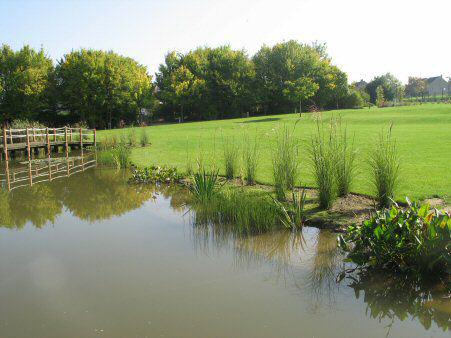 |
|
Giancarlo Fantilli et Les Simonnet, Parc des Terres Blanches (2005)

© ville d'amilly
Photo : 1 2 3 4 5 6 Le paysagiste Giancarlo Fantilli propose diverses expériences tournées vers le site et son histoire, la nature et les sens. Les trois thèmes traités (l'aire de jeux pour les enfants, l'aire écologique et l'aire agricole) sont nés de la topographie de la combe, de l'importance du parc à l'intérieur du centre bourg, d'une considération des besoins et nécessités conjugués de plusieurs générations, sans oublier ceux des animaux et des plantes. Le projet affirme la spécificité du parc en tant qu'espace aménagé et délimité ainsi que son pouvoir de stimulation et d'éveil.
Laisser parler le site favorise la rencontre sensible. Pour les enfants, il s'agit de "stimuler, à travers le jeu, la connaissance directe et sensorielle des matériaux naturels". L'aire écologique est constituée d'une prairie naturelle protégée et d'un étang. "Située dans la partie la plus basse du parc, celle-ci offre un lieu de détente et aussi un endroit où l'on peut connaître directement les plantes et les animaux qui habitent les zones humides de la région". L'aire agricole est plantée d'arbres fruitiers. Dans ce jardin va naître et progresser toute une série d'activités liées au savoir et à la transmission des traditions agricoles, en rassemblant spontanément ou en associations des citoyens de tous les âges et en stimulant surtout les échanges entre les plus jeunes et les anciens"
Giancarlo Fantilli
Une sculpture-jeu des architectes et sculpteurs Les Simonnet est installée dans la grande prairie. Sa couleur rouge vif tranche et apporte une note éclatante dans l'environnement verdoyant du parc et les tons pastel des façades d'immeubles. En résine lisse, elle invite au contact physique, à l'appropriation par le jeu.
Giancarlo Fantilli and Les Simonnet, Park of the Terres Blanches (2005)
Landscape artist Giancarlo Fantilli has imagined a variety of experiences based on the area, its history, its natural environment, which also bring sensory experience into play. Three thematic areas (the children’s play area, the ecological area and the agricultural area) were decided on after consideration of various factors: the combe valley type of topography, the size of the park located in the town centre, the needs of several generations of local people, as well as the conditions required for wildlife to flourish.
The project defines the park’s specificity as a planted area and acknowledges its potential for stimulating awareness of the natural environment. Allowing the park to speak for itself heightens sensory perception of the environment. Children’s “direct sensory awareness of natural elements can be stimulated through play”.
The ecological area is made up of natural grassland that is protected, and a pond area. “Located in the lowest area in the park, it provides space to relax in, a place to get to know the plants and animals that inhabit the region’s wetlands.” The agricultural area has been planted with fruit trees. This orchard area will be home to many activities linked to the transmission of traditional agricultural skills as people of all ages gather and spontaneously exchange their know-how, particularly the older to the younger generations.
A play-sculpture, by architects and sculptors Les Simonnet, has been installed in the grassland area. Its bright red colour provides a dramatic contrast to the leafy green park and the pale tones of the buildings. Made of smooth resin, it invites touch and appropriation through play.
Giancarlo Fantilli und Les Simonnet, Der Park in Terres Blanches (2005)
Der Landschaftsplaner Giancarlo Fantilli schlägt verschiedene Erfahrungsmomente über den Ort und seine Geschichte, die Natur und die Sinne, vor. Die drei Themen (ein Kinderspielplatz, ein ökologischer und ein landwirtschaftlicher Platz) sind aus der Topographie der Schlucht entstanden, der Bedeutung des Parks im Inneren des Marktfleckens, einer Einbeziehung der Bedürfnisse und Pflichten mehrerer Generationen, ohne dabei die der Tiere und Pflanzen zu vergessen. Das Projekt macht die Besonderheit des Parks als angelegtem und begrenztem Raum deutlich, als auch seine Fähigkeit zu stimulieren und Aufmerksamkeit auf sich zu ziehen.
Den Ort für sich sprechen zu lassen, begünstigt sensible Begegnungen. Die Kinder sollen „durch Spiele stimuliert werden und die Naturmaterialien konkret und sinnlich erfassen“. Der ökologische Platz besteht aus einer natürlichen Wiese und einem Teich. „Am untersten Teil des Parks angelegt, bietet er einen Erholungsort und die Möglichkeit, Pflanzen und Tiere, die in den feuchten Zonen der Region leben, kennen zu lernen“. Der landwirtschaftliche Platz ist mit Obstbäumen bepflanzt. In diesem Garten werden eine Reihe von Aktivitäten entstehen, die mit dem Wissen und der Vermittlung landwirtschaftlicher Traditionen verbunden sind, wobei sie spontan oder organisiert Bürger/innen jeder Altersgruppe zusammen bringen und vor allem den Austausch zwischen den Jüngsten und den Älteren fördern“. Giancarlo Fantilli
Eine begehbare Skulptur der Bildhauer Les Simonnet steht auf der großen Wiese. Ihr lebendiges Rot hebt sie ab und bringt eine deutliche Note in die grüne Umgebung des Parks und die Pastelltöne der Gebäudefassaden. Aus glattem Harz gefertigt, lädt sie zum körperlichen Kontakt ein, zur Aneignung durch das Spiel.
|
|

